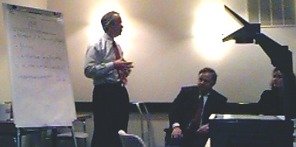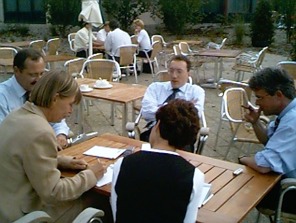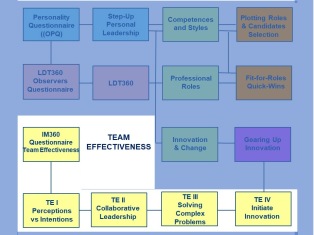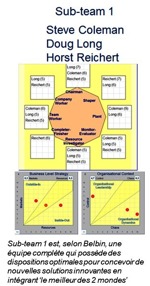PROGRAMME TEAM EFFECTIVENESS
About the Team Effectiveness Program
The Team Effectiveness process was developed by LDpe in co-operation with the Capgemini University and it has been applied more than 30 times since. The pilot took place in 2005 in Shanghai with the Capgemini China Management Team.
Since then the program has run in the Benelux, Scandinavia and a number of other countries, with international, interorganisational or local management- and project teams.
Preconditions
A major precondition for a team to participate in LDpe’s Team Effectiveness Program is that all team members have the willingness and readiness to:
- build up trust in one another;
- be fully open and willing to enter a critical dialogue with one another;
- be committed to the process and its outcome;
- and are looking forward to the joy and fun of really getting to know each other and
of co-operating as a team.
Workshops
The set-up of LDpe’s Team Effectiveness Program has been based upon and makes use of the most advanced insights and expert theories.
The program includes a series of one-day workshops for teams. Every workshop follows a well thought-out format and is supported by a unique enabling toolset.
In a systematic way, the team will stepwise strengthen its functioning, improve the interaction between the team members, who learn to deliver effectively as a team.
Subsequently, the team will focus on identifying its challenges, while testing and challenging its strategies and driving innovation.
TE I and TE II (Perceptions versus Intentions and Collaborative Leadership) will focus on the creation of trust and foster an open dialogue between the team members, on really getting to know each other’s qualities and becoming an effective team.
TE II (Collaborative Leadership) will further be the start of defining tasks and setting direction and will initiate the readiness to deliver as a team.
In TE III (Solving Complex Problems) the team will be challenged to reflect about and describe its strategic challenges, and sub-teams will be composed for the creation of innovative solutions.
Team Effectiveness I and II
The first two Team Effectiveness workshops follow the three team effectiveness dimensions as defined by the research at Maastricht University:
internal effectiveness, intermediary effectiveness, external effectiveness.
In advance of the TE workshop series, we will measure the team members’ perceptions about the mutual interaction patterns.
This inventory, based on Timothy Leary’s Interpersonal Circumplex model,[1] creates a good starting point for the improvement of the team’s internal effectiveness in the first workshop: Perceptions versus Intentions.
[1] The interpersonal circle or interpersonal circumplex is a model for conceptualizing, organizing, and assessing interpersonal behaviour, traits, and motives (Wiggins, 2003). Originally it was coined Leary Circumplex or Leary Circle after Timothy Leary.
With LDpe’s IM360 interaction model, based on this circumplex we enable the team members to separate content and interaction while analyzing their mutual communication.
The IM360 interaction model
- Our (often unconscious) behaviour is
the source and the result of the
others’ (often unconscious) behaviour.
- We think that we communicate on
content, but the (unaware) imposed
relationship is at least as important for
effective communication.
- The 360º Interaction Model can help us
to separate the content and the
imposed relationship and help us
analyse the effects of our
communicative behaviour.
- The model can help us reveal the
different perceptions about the way we
communicate and influence others.
- The assumption is that more clearness
about the way we perceive and
influence each other may lead to an
improved effectiveness in
team co-operation.
Perceptions versus Intentions' focuses on 'internal effectiveness', the inter-relations between the individual team members will be discussed among themselves, while analysing the differences between perceptions and intentions.
The second workshop focuses on the intermediary and external effectiveness, the interaction with subordinates and the external world and on the team’s readiness for delivery:
Collaborative Leadership.

The first deliverable is a for the organisation relevant development project.
After the workshop the project continues until all project goals are realised: the workshop transforms into a project.
DETERMINANTS OF
MANAGEMENT TEAM EFFECTIVENESS
Research in science and practice
Based on intensive observation and interviews with managers and management teams, research at Maastricht University (Raes, Glunk, Heijltjes, & Roe, 2007) has identified the interaction between MT and lower–level managers as crucial for organizational effectiveness.
Thus, a management team’s overall effectiveness depends on three factors:
• internal effectiveness: the quality of
interactions between team members,
which is the basis for good interpersonal
relationships and high-quality decisions
• intermediary effectiveness: the way of
interacting with lower-level managers,
which leads to acceptance of the MT’s
views and decisions
• external effectiveness: the degree to
which the MT creates conditions that
enable the organisation to carry out its
decisions.


In Collaborative Leadership, the team defines its 'delivery project', a project in which the group delivers as a team.
As a project the team mainly chooses a strongly felt need for change within the organisation, a strategic plan that needs to be realised, or the development of a year plan or a business plan.
Team Effectiveness III
The third workshop, called Solving Complex Problems, will enable the team, or an extended team including some closely involved professionals, to work out new solutions for the organisation’s strategic challenges. A number of subteams will elaborate rejuvenating and/or innovative solutions.
Strategic issues are often based on wicked problems, strategic paradigms, with extreme, seemingly contradictory solutions, for instance:
- centralisation versus decentralisation,
- market driven versus resource driven development, etc.
Since every individual is biased in generating solutions for this type of problems, the team needs to be aware of the necessity of composing some 'complete and balanced' subgroups for finding the synthesis, solutions combining the 'best of both worlds'.
Those sub-teams will be put together with the help of LDpe’s Advanced Team Design Tool (ADT). This tool is based on both the paradox theory about strategic challenges and Belbin’s team-role theory.
A precondition for participation is that all team members have completed a personality questionnaire, either as step in the personal development process (LDT-based Career Counselling) or just for the sake of participation in this workshop.
Team Effectiveness IV
In the fourth workshop, called Initiate Innovation & Change, the team mobilises the forces for innovate developments, necessary to cope with changing market conditions and position the organisation for the future.
This workshop is the starting point for the process 'Gearing Up Innovation', as described in the Chapter Innovation & Change.








